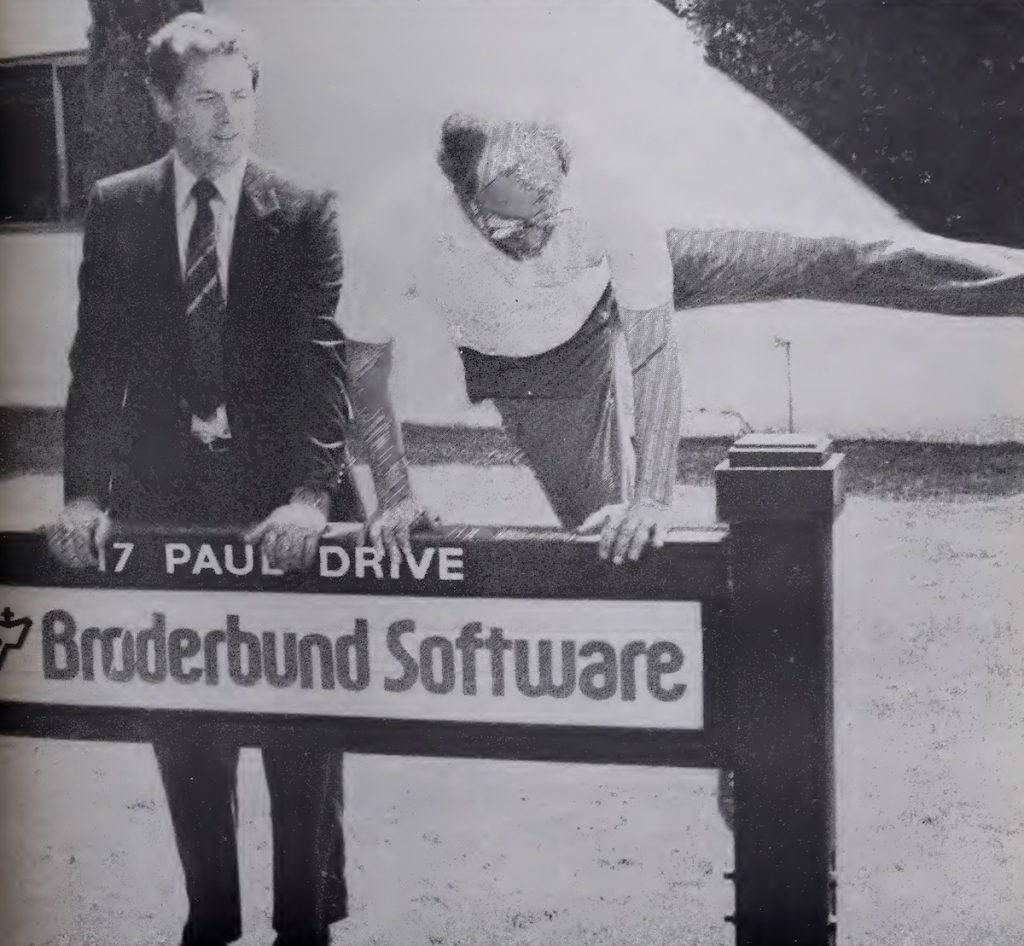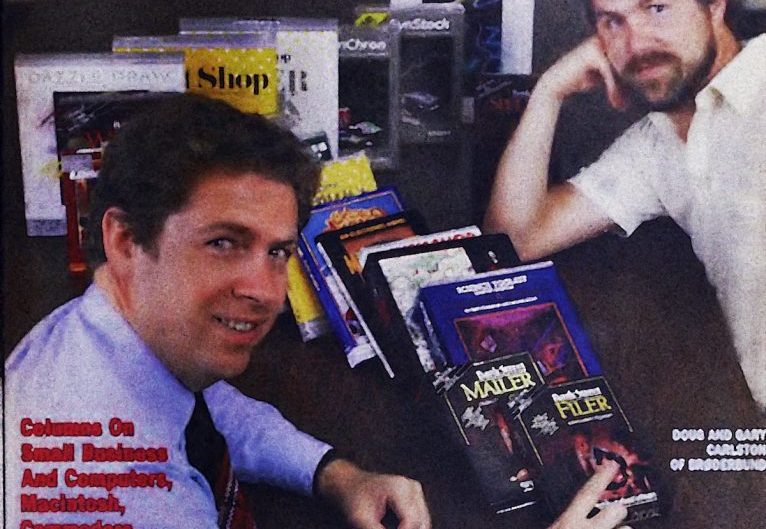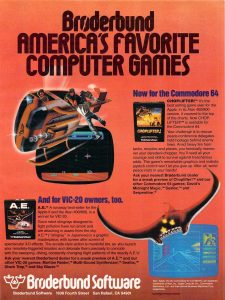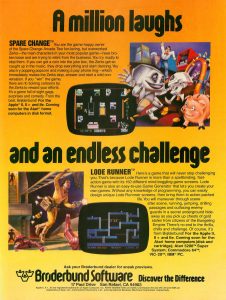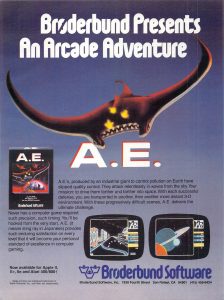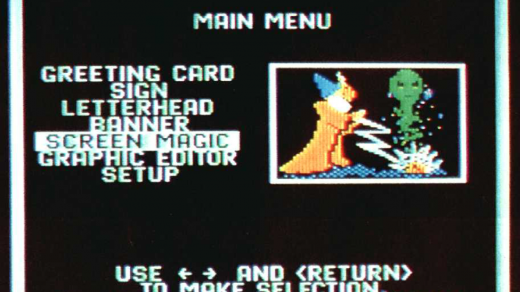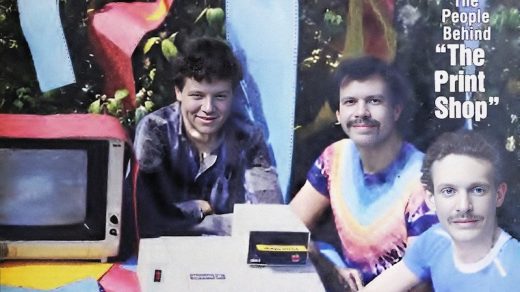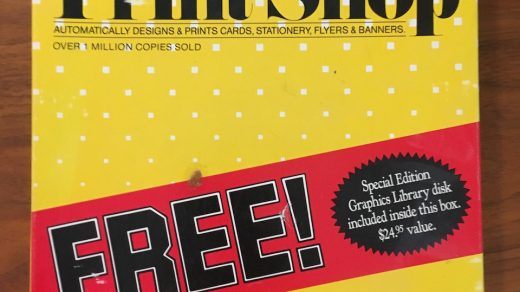
Brøderbund Software Inc. was founded by brothers Doug and Gary Carlston in 1980 after Doug had written Galactic Empire, a space strategy game, on his TRS-80 (retro-trivia: many of the locations in the game have names taken from African languages, based on Doug’s years in Africa).
Gary found success selling Doug’s game to computer stores, and the pair decided to start their own software publishing company. They chose an Afrikaans word Doug had used in Galactic Empire, Broederbond or ‘association of brothers’, for the name of the company, but altered the spelling slightly to be unique.
Their sister Cathy joined them a year later, and they were off and running, publishing titles such as Choplifter (1982), David’s Midnight Magic (1982), Lode Runner (1983), Gumball (1983) and Karateka (1984). By early 1984 technology magazine InfoWorld estimated that Brøderbund was tied for the rank of tenth-largest microcomputer software company, and was the largest entertainment software company with US$13 million in sales in 1983.
In 1984 The Print Shop would skyrocket the company’s sales even higher; 1985’s Where in the World is Carmen Sandiego? began a franchise that included a children’s television program and 1989’s Prince of Persia would eventually be made into a movie! In 1991 Brøderbund ‘went public’, trading on the NASDAQ stock exchange as BROD. At the time The Print Shop comprised 33% of total revenue and Carmen Sandiego 26%.
However, in 1995 the market landscape began to change, and after a failed attempt to buy educational software company The Learning Company, Brøderbund’s profits started to suffer. Its stock price began to fall and it became a takeover target. Rival SoftKey, which had bought The Learning Company, discounted one of its acquisitions, a knockoff of The Print Shop, and further drove down Brøderbund’s profits, lowering its stock price further and ultimately SoftKey bought the company.
Firstly, you gave up being a lawyer to make video games! What were you thinking?
Well, that’s not quite what happened. I was in high school in the early 60s and went to a summer program for people who thought they wanted to be engineers, and they introduce you to civil, mechanical, electrical, analog computers, digital computers; and they taught us Fortran. It was a natural for me, I felt very comfortable doing it. When I went off to college, I needed to pay for school and so I got a job at the computing centre – I had done that in the summer at the university in the midwest where I grew up too, so I had been programming – not games – I had been programming payroll programs and things like that, boring stuff. I then went off to live in Africa, I did other things, I was not around computers – they were big; you needed a very large room for a computer back then.
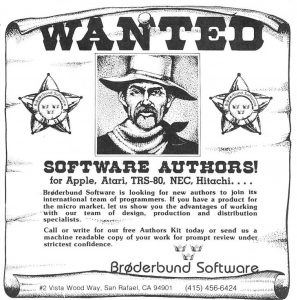
When I came back to finish school I went on to grad school; I went on to law school; there were no computers in my life there. I think it wasn’t until the late 70s, I got a personal computer to help around the law office, to do the boring parts. I hated the idea that you pretended you were doing something original for everybody but it was all pretty cookie- cutter – you really had twenty questions when you were doing a will and you could kick it out, which is what happens now. And so I just wrote the code for those on my little Tandy TRS-80, which I think was a $400 computer at the time. What I found was that I wanted to use the computer to the extent that I could and that meant using things like the very limited graphics capability – I think it could make white dots and that was about it – so I wrote some games just to use parts that I didn’t use doing wills and trust programs. It was fun, and my friends enjoyed it; my siblings enjoyed it, and at some point – I think 1980 – I decided I hated being a lawyer, I loved programming and I was going to figure out a way to get back into that universe, although that was not at all clear.
So I spent a few weekends writing simple games and sending them off to a company called Adventure International in Florida, and they took them immediately and started selling them and sending me money, which surprised me. So, since they hadn’t asked for exclusive rights, I sent the same games off to several other publishers and they all accepted them; they just competed with each other with the same content. But it doubled or tripled the income from it, and it was starting to match what I was earning as an attorney and I thought it’s a whole lot more fun, so I gradually – and it took about six months – closed down the law office – you can’t abandon people, but you do it slowly. Since you don’t need to be in one place with computers and since I was at that point living in the north-eastern part of the States in Maine which is very rural and quiet and my family and siblings were all over the country – Americans don’t tend to stay put very long – I decided to drive across the country and visit my friends and family slowly and just working at night, which is when coders like to code anyway, and driving during the day and work my way gradually across to Oregon, in the north-west part of the country, to visit my brother Gary.
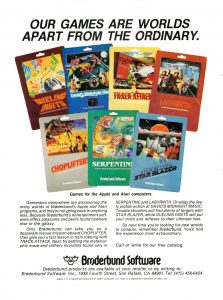
He had been running a non-profit organisation; he was bored, and I said, “Why don’t we start a software company? I code, I have a whole bunch of things I’ve written that I haven’t sent off to the publishers yet, and you could sell them.” He said, “Well, I’ll try,” and we picked up a computer magazine and there was a store in Washington DC run by a guy named Ray Daley. Gary picked up the phone, called him and said his name and the guy says, “Oh, are you related to the guy that wrote the Galactic Saga?” Gary says, “Yeah, he’s sitting right here, he’s my brother.” Ray says, “Well, I’ll always buy from the source.” So, he bought $300 worth of those games, and that’s how the company got started.
So it sounds more quixotic the way you put it, but in fact it was a long, slow drawn-out process of me losing interest in practicing law for various reasons, part of which is it’s just not very creative in many respects – I don’t think, others may disagree – and I just loved coding, it was possible (for me) to get back into coding, and people who do it, just, it’s a drug. It’s very hard to stop. In fact, I knew I was in trouble when I turned in what they call ‘blueback’, a legal document that’s formal, and has a blue cover, and so forth, and without realising it I had gotten an idea while waiting for my chance before the judge – a coding idea – and I had just started scribbling on the nearest piece of paper, which happened to be the blueback, and he threw it back at me, and said, “What is this?” I realised I was not long for the legal world.
Every time my brother and I tried to do anything constructive together we always ended up fighting, but you managed to make a multi-million dollar company with yours. How did you manage to get along with your siblings?
I think the problem is that in any sane, normal family you’re all equals, and so hierarchy doesn’t work very well in that. You’re used to calling each other out every time somebody gets a little uppity or too big for their britches or whatever and that’s what siblings are for, they’re supposed to do that. And so our solution usually was to fight; yell at each other – which terrified the rest of the company: “oh, the company’s going under” and so forth, but of course we had forgotten about it five minutes later. We had very short memories in my family – it’s congenital, even now I can hardly remember my name. It didn’t hurt us; we did learn to tone it down because it was scaring the staff. So we stopped doing that. Also three is easier than two, because there’s always an arbiter, there’s always a third person – usually it was Cathy, my sister, who would say, “Would you guys just cut it out? You both are sounding ridiculous,” and then you stop.
So I can’t say we didn’t fight – we did fight – but generally we worked together well, and we were all smart in different ways and that helped, we could find ways to work together. We also moved around inside the company – we didn’t always do the same things. I couldn’t code after the first year really, because you can’t code and answer the telephone, you can’t have your attention span broken constantly and yet, we didn’t have enough people that you could just go lock yourself away in a room. So that ended up terminating my coding career for about twenty years. Although I do it now, but that’s to keep the Alzheimers away.
Also, Gary, Cathy and I had worked together before; we built houses up in Maine and stuff like that, and so we had some experience in working with each other. And, because I was the oldest I got to be the boss and they did not like that, and so they constantly told me when I was behaving like a so-and-so. But we’re going to play tennis tomorrow morning – it’s a permanent thing, being a family as far as I’m concerned. And Cathy would be here with us except unfortunately she passed away a long time ago.
By most accounts you treated your software developers really well. Was this a personal or a business decision?
I don’t think we overtly thought about it as treating people well, it was how we were raised. We were also not in business to be in business – we were originally in business to get free software from other people and make a living, put food on the table. We liked hanging out with one another – we hung out with most of our competitors, we would go on these whitewater rafting trips with seventy or eighty people and they were mostly from other companies, so it was a time when this whole industry was so new that when you found people in it, it was a joy. I remember I did one sales trip our first year – cold calls give me the sweats – but I drove across the country 3000 miles and stopped in every town, found a computer store, loaded up software on their machines and they’d come out all upset that someone was touching their devices and then they would buy from me. I will say that about half the stores I ended up staying at their houses at night, because once they found another true believer – and these people were not shopkeepers, they were computer geeks who had a store so they could hang around the computers all the time, and they really didn’t want customers because they got in the way of their ability to enjoy the merchandise.
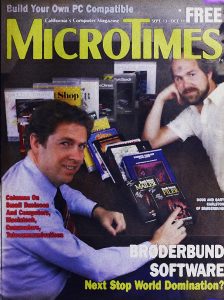
So, it was a very social time, and I think honestly family has something to do with it; my Dad was on sabbatical in year three or four and my Mom had nothing to do. So she came and became our first project manager. Basically she supervised a lot of the outside engineers, and she was known as Mom to them too I think, in a lot of case. And I have to say that a lot of those early developers remain good friends of mine today. Yes, it was a business relationship and we negotiated – and some of them negotiated really hard. Jordan Mechner was a great example, he did Prince of Persia – he lives in Montpelier, France now and we go visit when we can – we would offer him a 20% royalty and he’d say he wanted 50%. I asked why and he said he did half the work! And so I’d sit down with the whole accounting table and say, “Okay, here’s how all the money is spent. Here’s our profit which is around 15%, which is less than what you’re going. So explain to me what you want to cut here – here’s the marketing, here’s the cost of goods. Do you want cheaper boxes?”
But if you’re honest with people and up front it’s sort of a game to them too, there’s a sense of newness about it and pleasure. We did do one thing nobody else did because it was important to me (as) I was getting royalties for a while: until Broderbund was blown up, after 18 years, we paid royalties on a monthly basis. The idea was that people could live on that. If you did it twice a year like book publishers, suddenly the level of uncertainty in your life is too high. The idea was to spread it out, they would be less likely to blow it on a Porsche, they’d be more likely to get groceries, stuff like that. I don’t know if that was true, we had plenty of them who blew it on Porsches.
Speaking of Porsches, Print Shop developer Corey Kosak was known to drive one?
Corey wasn’t the founder of Print Shop, he did what we called ‘ports’ – he converted versions of it to other machines. The original, which was on the Apple II, was done by Marty Kahn and David Balsam; Marty was an employee and David wasn’t, it was complicated but we worked it out. David and Marty were a couple, and Corey – I had met Corey when he was 14 and as he grew up he decided he was interested in men – and so they became friends. Corey came from a dysfunctional family, but he had been the outstanding student in his high school and he was invited to give a speech before graduation and he had a table for guests. He invited me to come, and he got up there and said, “This is great honour, and I certainly hope this portends a Porsche in my future.” And then he sat down. He didn’t want to go to college; he went to college for three months and dropped out, then he worked for us for three more years and I finally talked him into going back to college. He still isn’t convinced it was a good use of his time but I thought it would broaden him.
But it was not atypical for these guys, who were 20 years old or 19 or whatever. Our royalties didn’t cap so when they had a huge hit, it was sometimes millions of dollars, and it could be millions of dollars inside a year when you’ve never earned anything before. Even if you get it monthly it still mounts up very, very quickly and you think it will go on forever. And Corey was one of those guys who claimed never to have an original idea, so he never got the full royalty because he never created a product on his own but he did all these ports – he could learn new machines overnight. And so he could go to David and Marty and say, “You guys just do the Apple II and I’ll do the PC and the Commodore and the Atari.” He could do them all, and he could do them fast.
The first program he ever gave me he gave to me in foolscap – he came in, he was 14, and said, “I have a game I want you to publish,” and I said, “Sure, give it to me and I’ll take a look at it.” He said, “Well, it’s on this piece of paper, I don’t own a computer.” So I sat him at my desk and I said, “You can come in on weekends and use it straight through until you’re done.” I happened to be there when he finished and he said, “Okay, I’ve typed it all in, wanna see it?” And it worked right off the bat, which as a programmer that never, ever happens; there’s always errors. Except he never makes mistakes, as far as I can tell. I said, “This is great; it’s fabulous; it’s completely derivative!”
He said, “What do you mean?” I said, “You just copied Zork and changed the names!” He said, “Yeah, but I didn’t look at their code! It’s all original!” I said, “Yeah, but not in the eye of the beholder it’s not. To the player it’s exactly the same. So you’ve proved you’re a really good programmer, but you probably need some help with ideas. Why don’t we do some ideation?” And in the end, he said, “Why don’t I just help other people? I can code like crazy but I don’t want to create the whole thing, that’s just not me.”
And that’s still where he is, although he’s been in New York for years now and he’s taken many other routes – he even worked for Google for a few years as a senior engineer. But we try to see each other when each of us is available. He’s a good guy.
How did The Print Shop come to be a Broderbund product?
When we hired Marty, he said, “Anything I do is yours, except there’s this one thing I’ve been working on with my boyfriend called ‘Perfect Occasion’. It’ll put up a greeting card on the screen and you can send it to people and they can see a birthday card or an anniversary card on their computer. And so I want to hold that up. And if you want to publish it you can publish it but I need a royalty on it, it can’t be part of my salary because half the royalties are going to David.” I liked it, and I said, “That’s okay, we can do that if you want, but it’s not ready to publish because I want it to actually print output.” He said, “That’s impossible. Do you know how many different printers there are? Every one needs printer drivers, we don’t do printer drivers.”
I said, “Well, what if we (Broderbund) did the printer drivers? I could work relationships out with all the printer companies and they would probably want to bundle your product with (their printers).” And so we ended up doing that. Marty stopped working for us because he made so much money off The Print Shop that he decided he would just do that full-time and he and David did that and Print Shop Companion and a few other things, but then they moved to Nova Scotia and I think they kind of stopped coding. It was one of those brilliant moments in their lives, it made tens of millions of dollars for them, and they lost all incentive to work because they could play and I think they just played. I don’t know that (for certain), you might ask them.
So that was a case where one of them started as an employee, but he had one great idea – and it was good – and they did it for a while. When the whole market changed and it went away from pixelated graphics and to vector graphics, they tried to find the time to do that and finally they said, “Could we just give the project to somebody else?” And so we took it over and it became an internal project at that point.
When you first saw The Print Shop, did you think it was going to be as big as it was?
You know, nobody knows, when you’re starting an industry you don’t know how much the industry is going to grow, you try to do stuff that you like, that you would use and isn’t imitative of stuff that’s already out there – and I know Print Shop ended up with lots of imitators but it was the first one, and in fact we OEM’ed it with over a hundred printers because there wasn’t anything like it and they were still trying to convince the average user that they needed printers – people still had typewriters, they weren’t used to using their computers as word processors, which I would have though would’ve been the driving force behind printers. But it turns out greeting cards were more compelling because you couldn’t use dot-matrix printers to make something that looked good enough to send out a formal letter on but you could certainly make a cute card and send it off to grandma. And so that’s what people did, and the printers took a while before they got to a level of quality that they could be used seriously.
By extension, did you think Broderbund was going to get as big as it did?
I don’t know that we spent much time thinking about it, we had to think a little bit about it when the venture capitalists came calling and saying we wanted to invest in you and so on; but at the time it seemed kind of like a game, and we were flattered they wanted to give us millions of dollars and so forth. And we did end up doing it – I think in retrospect it wasn’t the wisest decision in the world because it put us on a track to turning into a public company, which is how we lost it in the end. But it was not in our nature, I think, to spend a lot of time thinking about that as much as worrying about where the next products would come from.
Every year you had to have – I don’t know – we put out, in terms of totally original products – not ports, not derivatives, not follow-on products – probably no more than 7 to 10 products a year. So it wasn’t a huge number. We had a process of looking at submissions, but we probably published less than one out of two-hundred submissions. This was before products got so complex that individuals couldn’t do them, but that you needed whole teams of people, and we often added the music or the animation effects and so forth. We helped people who had a great creative idea. Like Lode Runner, Doug Smith’s product, the character was just a little five pixel, not very animated character running around and we helped him reimagine it and make the character larger and give it personality and add in sound effects and stuff like that.
There were a lot of products that between our staff and between the outside authors were made. There were some that came mostly internally; the Carmen Sandiego line was an internal line of products based very, very loosely on some games my brothers and I had played when we were kids in bed at night, because we liked geography and we would challenge each other – when there’s three you can always have one judge and the other two compete and you move it around, and so we’d be like, “You’re walking from Botswana to Mongolia, tell me every country you go through,” and the judge would say, “Nope, can’t do it, they don’t touch each other,” and would have under the sheets an almanac, or something like that, and a flashlight to check it out.
But for a long time we did not create a lot of stuff internally. We mostly did ports or extensions. We tried to source things externally – and actually that went up right until the end. Many of our biggest successes, even in the 90s, were external. Like Myst came from Rand and Robyn Miller up in Spokane, Washington; I had spent two years trying to track them down before I finally – I put the word out, and finally a friend of mine in New York and said he knew where they were, they were in Spokane. I went up and met them and got them on board. And Myst was the third thing I think they’d done for us, so they got better by leaps and bounds as they went along. I think generally the issue of whether you do it internally or externally is based in large part on the complexity of what people are trying to do.
Over time, in the 90s, the teams got larger and larger and larger, and it became less obvious that the engineer or the coder was the key person; sometimes it was the person who created the idea but had no technical skills at all. And so we tried to do royalty shares, and that got as ugly I think as the movie business for a while, and then it moved from money to credits – who got their name how big, and so I threatened to put everyone on in alphabetical order, then at one point I said I was just going to take the credits off, and I got pretty beat up on that one, it lasted one day.
But basically the problem was it was changing to professional development teams who still needed publishers. And so groups would form of people who had their own animators and artists and colourisers and audio people and so on – we did have audio studios in the office, and we had, I think, thirty artists who work on staff and so on. That was substantial but that wasn’t everybody; in fact, the games part of the business – that’s another thing that a lot of people don’t know is that Broderbund historically was probably about 10% games in terms of revenue, and we never said no to it. Microsoft was, for a long time, they were doing Olympic Decathlon; this that and the other and Bill Gates would’ve done them forever but Steve Ballmer and the others beat him down and said, “That’s not good for our professional image, you’ve got to get away from the games.” We never cared and so we just kept on doing whatever, although at some point the educational market didn’t like some of our games because they had violence in them, so we started publishing the games under a sub brand which was Red Orb, which was just Broder spelled backwards – that was not my idea – but I think that had little effect.
So eventually what happened was the publishing process got largely separated from the development process except in things where it was possible to spec the whole thing up front, what they call high-concept products. And I think that’s how it eventually evolved. Even people who stayed in games, like Electronic Arts which was always all about games, one of the things – and this came from Don Mattrick, I think, more than anybody else, he said that the way to keep people is to do high concept evergreen products. He said, “Well, what does that mean in games? Evergreen products are products you can sell year after year, like Print Shop, which sold for 20 years. Most games last a season. But they don’t have to. They can last year after year if they depend on data and if the data is replaceable every year.” And I said, “Like what?” And he said, “Sports games. Sports games with real characters.” I said, “It’s all licensing, and that’s very big dollars” – and in fact, we never successfully did that, but they did develop the capability of doing that and eventually went after originally individuals and eventually whole leagues, players that played soccer, stuff like that.
That made it evergreen, what made it high-concept was the nature of the game, the game had rules that were already inherently known by people, people looked at it and said, “Okay, this makes sense to me,” off the bat. Whereas most games that we learn at some point in our lives you have to go through a learning process when it’s perhaps not as much fun once you know the rules. By focussing on well-known sports and not making new sports they piggyback off learnings that people have already made before they got to the game.
As you got bigger, did personal relationships tend to suffer between you and the developers?
Well, other people had to do it, because I couldn’t do all that myself. I still tried to evaluate stuff that came in, because – founders had an advantage over employees when it came to accepting high-risk enterprises such as accepting a product for publication. When I had teams doing that they just rejected 100%. It was 99 to 100 – it seems like a small difference, but it meant our whole supply was cut off. So I stayed back in sourcing new product. But one of the problems with size is that you can’t maintain direct personal relations with everybody, and so you do have people who work with development groups, including the ones we’ve been talking about who were early developers and remained friends, but they weren’t working through me. And in fact one of the hardest difficulties was when I would hear, like, Corey was having a problem with his product manager. And I couldn’t interfere, but I didn’t want them to burn a relationship that I’d had for over ten years.
So yeah, it becomes more troublesome that way. And also, as you get bigger, you don’t get to spend all your time on the creative process, it’s harder and harder to do it. When you go public it’s the biggest single difference, because suddenly you have this huge external market you’re supposed to focus on, about whom I had no interest at all – I was interested in the product and spent as much time as I could (on that). I moved my office into product development at one point and left the corporate headquarters – we were in five buildings, but eventually we had to move into one big building and that got undone at that point. But that was the heart and soul of the organisation so you tried to stay as close to that as you could. I never knew beans about sales and marketing and just hoped for the best. We had a variety of different managers who all knew more than I did in both of those areas, and we got better and better over time, but not thanks to me at all. And we had a lot of processes that got put in place that were intended to ensure equitable treatment – the only ones that I’ll take credit for is that we gave options to all our employees, and what they were worth was tied very closely to when you started and how long you stayed, so we did have secretaries who ended up with millions of dollars worth of value because they came in the early 80s and stayed well into the 90s.
But you can’t have very much effect without spreading yourself very, very thin and so a lot of things you just let go of. In the early days, you just focus whatever’s the crisis – you can only do one crisis at a time; what’s the thing that’s most broken, I’d better focus all my energy there.
As you get bigger and have a more professional team, you don’t even do that so much – I’d brought in a COO from CBS that knew more about every aspect of business than I did, but didn’t know anything about software, and I thought that would be perfect because I could just spend my time in software. But even there, there were hundreds of people in the product development side, so I can’t maintain relationships with hundreds of people very effectively.
So yeah, that did get a lot harder. And you spend a lot of time on the road doing talks and stuff like that. So not nearly as much fun. And that was the other thing – my sibs both quit after nine years; my sister just wanted to go off and have kids, and just have a family and not have to go to work every day, and my brother wanted to try living in different places – he wanted to live maybe in New Zealand or maybe Europe, he wanted to try other things. He said, “Doug, I’ve never had any interest in business. I don’t even think you do! But the truth is, I’m not enjoying myself anymore, and so I’m very grateful that it happened, and that’s wonderful, but I’m going to do some exploring.” And so he did, for fifteen years he lived away from California, although he basically lives down the street now, and has for the last ten years or so. But that’s just part of the human experience: you want to figure out what’s important to you, and get as much of that as you can.
What was it like personally for you when Softkey took over Broderbund? How did your employees deal with that?
Well, it was a forced sale, it was not a willing sale. They did things specifically to lower our stock price; they had bought the company that made PrintMaster, and sold it for $29.95 with a $30 refund – in other words they were giving it away, which depressed our stock dramatically, because Print Shop had for more than ten years been the most profitable product we had, and that had a huge impact on us. We had put a lot of additional things into Print Shop – we had a website developer, we had a photo organiser, we had a lot of things that were going into it. But we ended up just bundling more and more and lowering the price, and it was driving the price (of the stock) down. I had tried to prevent (Softkey) from acquiring a company called The Learning Company because we were in the middle of a merger discussion with them. They were a much better, pure educational company than we were – we had a lot of sales into schools because of the nature of our products, but we really didn’t design them to be educational. Print Shop was used widely in schools; Carmen Sandiego which we designed as a game but they thought was educational and so on. And so we thought it would make sense to give our educational sales department more to sell than what we had.
Softkey was just trying to roll up the whole industry, they were trying to buy all the companies they could and they had access to capital markets in a way we didn’t because that’s where they came from. So they could borrow a billion dollars and spend it this way and convince people to let them go on doing it. So I did a road show and tried to stop them. I tried to explain to their financial members what they were doing, which we won’t get into, but it was a complicated way of juicing the numbers, and basically the fund managers, who were all pretty young, said, “We know all that, but we don’t care. They give us good performance for three or four quarters, and then they dump a whole lot of losses that contribute to goodwill in their new acquisitions. We understand that completely.” Which I didn’t understand completely, but I was getting it. I said, “Why don’t you care?” They said, “Because our performance looks good most of the time, and that’s all we care about.”
So I lost that battle; we lost that company, although the people that owned it remained friends, but they said, “Look, our shareholders will take the best offer, you have to either offer more,” – which didn’t make any rational sense – “or we’ll go with the highest offer.” And then I think it was only a year later (Softkey) came after us, we were kind of the last one standing, other than Electronic Arts which had grown fast enough that they couldn’t afford them, they couldn’t get to them. And so we lost the company at the shareholder level – we had tried to explore a merger with Electronic Arts to fend them off; that was before they had actually put their offer in, and for various reasons that had to do with the volatility of the games industry – we were going up just as EA was having a temporary blip down, they missed Christmas with FIFA Soccer just as Myst was coming out and when the stock prices are fluctuating too much you can’t work out a ratio that both boards would accept. And so our board actually voted me down on that, they didn’t accept the merger proposal, and I think about a year later the hostile takeover began.
It was sad, and it was fairly predictable what would happen: they would flip all 200 companies to what we used to call ‘dumb money’ – in this case Mattel, who didn’t know anything about software, and thought they were buying a gravy train, and ended up with nobody who understood software at all, just laying people off as fast as they could to try to get back to break-even. They were losing a million dollars a day, I think, on it, and we had at the time 1700 employees and I think a year later maybe 30 still had jobs. It was catastrophic.
Now, I’ve stayed in touch for 18 years now with many of my staff, we have reunions here every two years, although I think it’s time to stop. We’ve been having reunions longer than the company existed, so I think it’s time to stop. But I still run into people all the time, all over the county; in fact, my wife and I went this summer to go hiking in France and Italy; we used Turkish Air through Istanbul to get there because it was a better price, and we’re standing in the Istanbul airport and a guy turns around and says, “Doug!” And I looked at him and I didn’t recognise him, possibly because he weighed twice what he did last time I saw him, and he’d lost a lot of hair. He said, “I used to run the music department at Broderbund!” Then I realised of course who he was and I remembered his whole story and everything but I just didn’t recognise him. He was on his way to India for business; he’s still in the music industry and doing stuff. So you run into people in the unlikeliest places, which is wonderful; it’s great.
